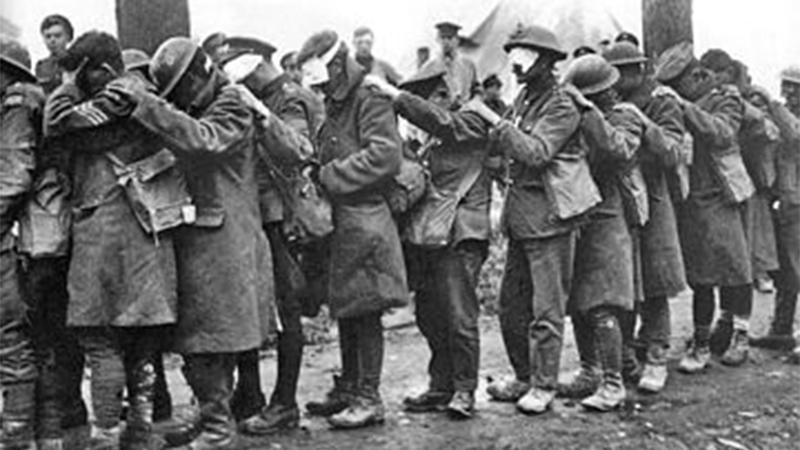Captain James Basey: “Case of Mystery”
Published 4:20 pm Friday, June 9, 2017

- British troops blinded by gas, 1918
Editor’s Note: This is the tenth installment of a series of articles about Polk County veterans of WWI whose names are listed on the Doughboy Monument in Columbus.
A 1920 publication titled “Soldiers of the Great War” states that Captain James D. Basey of “Tyron,” North Carolina died of wounds in World War I. But his name does not appear as a casualty on the Doughboy Monument in Columbus.
James Dodson Basey, a native of Oregon, studied engineering and architecture at the Universities of Wisconsin and South Carolina, and at George Washington University. He joined the Regular Army in March 1917, just weeks before the United States declared war. He was quickly promoted to 1st Lieutenant.
Hester Ripley, of Olympia, Washington, had married Hamilton Roach, an army infantry officer who was “retired disabled” with tuberculosis. The couple probably came to Tryon for treatment of his condition at Dr. Earl Grady’s Thermal Belt Sanitarium, now Pine Crest Inn. Dr. Grady signed the death certificate when Lt. Roach died there in 1917.
In February 1918, seven weeks after her husband’s death, Hester Ripley Roach married Lieutenant James Basey, who was stationed at Camp Green, Charlotte, N.C. The couple called Tryon home until he was promoted to captain, and shipped out to France with the 59th Infantry Regiment, 4th Division, in April 1918. He listed his military “home of record” as “Tyron,” North Carolina, a slip of the tongue and pen familiar to Tryonites.
Captain Basey led his company in combat at the Battle of Chateau Thierry on July 18, 1918, one of the first engagements for the American Expeditionary Force (AEF) under General John J. “Black Jack” Pershing. A few days later his wife, who had moved to Washington, D.C., was notified that her husband had “died of wounds” on July 19. On August 2 the Polk County News announced the tragic death to readers, among them the Basey’s “many friends in Tryon.” In the meantime, Captain Basey was recuperating from gas injuries in a hospital in the south of France.
Hester Basey received a letter from her husband written four days after his supposed death, and the Polk County News ran a headline, “Case of Mystery.” Mrs. Basey had sent copies of the captain’s hospital letters to “postmaster Stearns” in Tryon. The paper quoted Basey as saying that he and his company “…went over the top…at 4:30 a.m,” and that he “was knocked over by a gas shell, unconscious.” About noon he “toppled over and was…taken by ambulance to the field hospital.” He wrote that he was transferred to a hospital that had been a hotel in a famous resort, and that his only regret was that gas cases were not allowed to smoke. In a following letter he wrote that he has been exposed to phosgene, chlorine, and mustard gases, and that there were only a handful left of his 250-man company.
At the insistence of Mrs. Roach the War Department sent a cable to France to confirm the death or survival of her husband. A headline in the Polk County News for October 11, 1918 settled the question locally, proclaiming, “Captain Basey Alive.” Another letter written by the captain from his hospital bed was quoted as saying that “while coming out of his room he ran into a member of his old command, who remarked upon seeing him, ‘My God, Basey, where did you come from? Don’t you know that you have been reported killed?’”
Captain Basey returned to the U.S. in August 1919 to become a patient at a military hospital in Washington, D.C. He retired from the Army “disabled in the line of duty,” and was later promoted to Major. James and Hester Basey went to southern California, probably for health reasons, where she died in 1921 from tuberculosis, most likely contracted from her first husband.
Major Basey never re-married. He resided in Oregon, wrote on military topics, traveled abroad, and returned to France to do architectural photography. He died in Seattle in 1934, at age 41, his life considerably shortened by gas injuries. He was one of an estimated 1.3 million casualties inflicted by chemical weapon agents in World War I. In 1925 the Geneva Protocol banned their use in international armed conflict.
The War Department corrected its records, but the fate of Captain Basey is still incorrectly recorded in some sources. The archived editions of the Polk County News provide the answer to the nearly 100-year-old “Case of Mystery.”
– article submitted by Alan Leonard






